I know quite a few of you are wondering what happened to Sailu.Thanks for the e-mails making enquiries..:).Well,I am happy to announce that I am moving home.Yes, I have moved to my own domain at http://sailusfood.com and I invite you all to visit my new home. Thank you all for your kind words,support and encouragement.I'd appreciate if you could update your bookmarks and blogrolls and continue to support my site as you always have. Welcome to my new home at Sailusfood !
 Simple,comforting and flavorful – is how I would describe today’s vegetarian dish with overtones of North Indian style of cooking.I learnt this recipe during my college days from one of my numerous North Indian friends who would bring it in her tiffin dabba with rotis.I reminse the days when we would swap our tiffin dabbas and how I'd lap up delicious North Indian fare like stuffed paranthas and chole while my friends would relish our South Indian tiffins like masala dosas,idlis and garellu.
Simple,comforting and flavorful – is how I would describe today’s vegetarian dish with overtones of North Indian style of cooking.I learnt this recipe during my college days from one of my numerous North Indian friends who would bring it in her tiffin dabba with rotis.I reminse the days when we would swap our tiffin dabbas and how I'd lap up delicious North Indian fare like stuffed paranthas and chole while my friends would relish our South Indian tiffins like masala dosas,idlis and garellu.
I always tried out different combinations of a particular dish(which is new to me) using different spices with recipes like curried baby potatoes and aloo palak and finally settle for one which is suited to my palate in terms of spice and flavor.North Indian cuisine calls for the use of less spice than our Andhra cuisine.If I feel that the flavor of a dish needs to be peped up a bit in terms of spice then I do make a subtle change without playing too much with the ingredients and cooking style of the authentic original recipe.The end result has never been disappointing so far and I always had my family and friends relish the food served to them..:)
Aloo Tamatar Sabzi or Curried Potatoes in Tomato Sauce is very simple,everyday dish regularly cooked in many North Indian kitchens.Boiled potatoes are cooked in a spiced gravy of onions and tomatoes and it makes a great curry with rotis and chapatis.I also make this sometimes as an accompaniment to a subtle flavored rice or steamed white rice.
 Aloo Tamatar Subzi (Potato-Tomato Curry)
Aloo Tamatar Subzi (Potato-Tomato Curry)
Ingredients:
4 medium potatoes (boiled and slightly mash with hand roughly to form small chunks)
1 large onion chopped finely
3 cloves garlic finely minced
1" ginger finely minced
1/2 tsp mustard seeds
2 dry red chillis
10-12 curry leaves
2 green chilli slit length wise
1 tsp red chilli pwd (adjust according to your choice)
1 tbsp coriander pwd
1/2 tsp cumin pwd
1/4 tsp turmeric pwd
salt to taste
3 medium sized tomatoes finely chopped
1 1/2 tbsp oil
chopped coriander leaves for garnish
1 tsp jaggery or sugar (optional)
Heat oil in a cooking vessel and add the mustard seeds and let them pop.Now add the red chillis and curry leaves and stir fry for a few seconds till the flavors are released in the oil.Now add onions,ginger and garlic and saute till the onions turn light brown.Add the green chillis and all the pwds.Combine.
Add the tomatoes and stir fry till the oil seperates and it gets mushy.
Add the potatoes and combine and keep covered with a lid on low heat for 3-4 minutes.
Remove lid and cook further for another 3-4 mts stirring once in a while.
Add salt and enough water to cover the potatoes.
Bring to a boil and let it simmer on low heat till you get the desired curry consistency.Finally add the jaggery/sugar and combine.Turn off heat.Garnish with chopped coriander leaves.
Serve hot with rotis/chapatis/steamed white rice.
This is my entry to Sweetnicks Antioxidant Rich Foods ARF 5 A Day Tuesdays.
Did you know that the humble ,shriveled black pepper corn has a great history, status and a glorious past behind it? During its long and fascinating history, black pepper has often been more valuable than gold or precious stones and trade in pepper has been an extraordinarily influential factor in ancient history.
When Barbara of Tigers & Strawberries announced the theme "Ancient Spices" for her food event "The Spice is Right" ,the first thought that came to my mind were Seasame Seeds and Black Pepper Corns.Since I had already blogged about sesame seeds in one of my earlier posts "Nuvvulu Annam"(seasame flavored rice),I decided to blog about Black Pepper which is one of the most exotic ancient spice of India after saffron and is known to be the King of all spices.
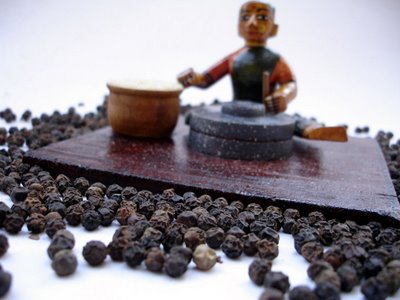 Black Pepper,whose name is derived from the Sanskrit word Pippali and Latin name Piper Nigrum meaning pepper black,is native to Malabar, the Western Coast of South India(Kerala).Black Pepper was a valuable spice during ancient times and was used as a currency to trade between east and west. It's been said that no other spice has had a greater effect on world history than pepper. The term ‘peppercorn rent’ actually came from rent which was paid in the form of pepper during the middle ages and that often a man’s wealth was measured by his accumulation of pepper.So high was its value that during ancient times it was used as a currency to pay taxes and there are stories of how 3000 pounds worth of pepper was paid as ransom/tribute when the Germanic tribe or Goths laid siege to Rome,soldiers being paid in pepper for a successful campaign,dowries of pepper given and it was also used as a sacred offering.Read more about the fascinating history of black pepper and how to select , store and tips on cooking with pepper
Black Pepper,whose name is derived from the Sanskrit word Pippali and Latin name Piper Nigrum meaning pepper black,is native to Malabar, the Western Coast of South India(Kerala).Black Pepper was a valuable spice during ancient times and was used as a currency to trade between east and west. It's been said that no other spice has had a greater effect on world history than pepper. The term ‘peppercorn rent’ actually came from rent which was paid in the form of pepper during the middle ages and that often a man’s wealth was measured by his accumulation of pepper.So high was its value that during ancient times it was used as a currency to pay taxes and there are stories of how 3000 pounds worth of pepper was paid as ransom/tribute when the Germanic tribe or Goths laid siege to Rome,soldiers being paid in pepper for a successful campaign,dowries of pepper given and it was also used as a sacred offering.Read more about the fascinating history of black pepper and how to select , store and tips on cooking with pepper
Ancient Chinese and Sanskrit texts dating to more than 3000 years ago have mentioned about black pepper with Ayurvedic nutrition and Chinese medicine advocating the importance of black pepper as an important spice with powerful healing properties and used in treatment of ailments of stomach and throat,considered to have anti-aging properties,good digestive and a detoxifier too.One of the best home remedies for cold and flu is drinking tea made of pepper corns and ginger.Aromatheraphy oil of pepper is used to clear the head,great for massaging aching muscles and for treating poor circulation.
This exotic spice with a sharp,pungent woody aroma and flavor when cooked for too long ,loses its flavor and aroma ,so adding it towards the end of the cooking will help preserve its flavor.To bring out the sharp flavor of black pepper,I prepared Miriyala Annam or Pepper Flavored Rice with pepper being the main ingredient and curry leaves and seasame seeds were used to offset the heat of black pepper.Hints of the aromatic flavor of curry leaves, mild nutty taste of seasame seeds and the sharp flavor of pepper blended into the rice giving it an irresistable authentic flavor.
 Miriyala Annam (Pepper Flavoured Rice)
Miriyala Annam (Pepper Flavoured Rice)
Ingredients:
3 cups of cooked white rice (each grain should be separate)
1 1/2 tbsp ghee (clarified butter)
1 tsp cumin seeds
3/4 tsp mustard seeds
1 1/2 tbsp black pepper corns
1 1/2 tbsp seasame seeds
10-12 curry leaves (fresh leaves only)
salt to taste
Dry roast the black pepper corns,sesame seeds and curry leaves in a pan for a few minutes on medium heat tossing them around till the flavors come out and you find a nice aroma emanates the kitchen.Once the seasame seeds change color you can turn off the heat and make a coarse powder.
Heat ghee in a pan and add the mustard seeds and let them pop.Add the cumin seeds and let them brown.Add the cooked rice and combine it with the tempering.Now add the ground spice pwd and salt and combine the rice with it such that the spices coat the rice well.The full flavor of the pepper is obtained on freshly ground pepper corns which enhances the taste of the rice giving it a sharper, more lively flavor than the pre-ground pepper powder and also by adding it towards the end of the cooking process which further enhances its taste.
Serve hot with any gravy curry or plain rasam ,appadam(papad) and curds.
Note:Use only fresh pepper corns and not pre- ground black pepper powder as it wont serve any purpose and you are definitely not going to enjoy the flavor of the rice if you use the store bought pre-ground pepper powder.If you venture into your kitchen to cook up this simple flavorful dish be prepared to use only the freshly ground pepper corns,I repeat..:)
Miriyala Annam or Pepper Flavored Rice is my entry to "The Spice is Right" - Ancient Spices" food blog event started by Barbara of Tigers & Strawberries.
Food,Food Blogs,Andhra Recipes,Indian Cooking,Flickr
 A major influence on Indian cuisine is the Muslim method of cooking,the Mughlai style,which is distinct in the fact that a lot of stress is laid on cooking the food over slow fire and the use of rich spices and nuts like saffron,almonds,cashewnuts,poppy seeds,elachi,dalchini and jaiphal to name a few ,liberal use of desi ghee and tandoor.Most traditional Mughlai food preparations include the use of curds and cream to produce a rich creamy gravy and the most important part of Mughalai cuisine is the perfect blending of the spices using the right proportions bringing a distinct aroma and flavor to the dish,be it the paneer kebab,meat kebabs or mutton kurma.
A major influence on Indian cuisine is the Muslim method of cooking,the Mughlai style,which is distinct in the fact that a lot of stress is laid on cooking the food over slow fire and the use of rich spices and nuts like saffron,almonds,cashewnuts,poppy seeds,elachi,dalchini and jaiphal to name a few ,liberal use of desi ghee and tandoor.Most traditional Mughlai food preparations include the use of curds and cream to produce a rich creamy gravy and the most important part of Mughalai cuisine is the perfect blending of the spices using the right proportions bringing a distinct aroma and flavor to the dish,be it the paneer kebab,meat kebabs or mutton kurma.
Palak Kofta is one such rich Mughalai dish where koftas which are balls made with spinach,potatoes and paneer are deep-fried and cooked and served in a rich creamy sauce prepared with spinach,onions,tomatoes and cashewnut paste.Its a labor intensive dish but its worth the effort and makes a great main course party dish and goes well with butter naan and rotis.
 Palak Kofta Recipe
Palak Kofta Recipe
Ingredients:
For Koftas:
2 tbsp grated paneer
1 cup palak leaves (washed and chopped finely)
1 cup of mashed boiled potatoes
2 green chillis finely chopped
1" ginger piece minced
salt to taste
2 slices of bread
Mix all the above ingredients and make small lemon sized balls,roll them in corn flour/bread crumbs and deep fry in oil.
For the Gravy:
1 big bunch of palak (spinach)- washed,blanched and pureed
2 big onions (blanch the onions and make a paste)
2 medium tomatoes (blanche the tomatoes and make a paste)
1 tsp ginger garlic paste
1/4 tsp garam masala pwd
1 tsp red chilli pwd
2 tbsps cashewnut paste
salt to taste
2 tbsp ghee (clarified butter)
1 tsp shah jeera (caraway seeds)
cream for garnish(optional)
Heat ghee in a cooking vessel and add the shah jeera and let them pop.Add the onion paste and fry for 4-5 minutes on medium heat ensuring that it doesnt burn.Add the ginger garlic paste and fry for another 2-3 mts.Add red chilli pwd and combine.
Add the tomato puree and let it cook over slow fire till the ghee seperates.
Add the palak paste and the cashewnut paste and combine .Add a cup of water and salt.Cover and cook for 10-12 minutes on low heat.Stir once in a while.
Lastly add the garam masala and mix well.Turn off heat.
Just before serving,spread the koftas on a serving plate and pour the creamy gravy over the koftas and garnish with cream (optional).Serve with hot rotis or naan.If you are serving the dish immediately on cooking, then you can add the koftas to the gravy and simmer over heat for a minute before serving.
This recipe with soft melt-in-the-mouth koftas served in an aromatic and rich gravy is an absolutely tantilising , irresistable dish that will have your family or guests licking their fingers..:)
Recipe Source:Adapted from an Indian cooking magazine

Weekends are generally barbaque times at our home and we did have a great kebab mela ..if I may say so..:) with colorful succulent pieces of paneer kebabs and delicious chicken tikkas ,on Sunday evening.Some of the marinated paneer pieces were still sitting in my refrigerator and the sudden announcement of an arrival of a guest,I knew it was time for another barbaque...:).Paneer Kebabs are marinated paneer pieces grilled or barbaqued in a traditional tandoor along with onions,tomatoes and capsicums(bell peppers.Away from the monotony,I tried my hand at 3 different marinades,each imparting a different color and taste to the paneer.The subtlety and balance of the flavors, infused in the paneer pieces along with crunchy vegetables makes paneer kebabs,a delicious appetizer or starter. Tri-Colored Paneer Kebabs RecipeIngredients:Yellow Colored Paneer Kebabs 8-10 paneer pieces (cut into a 2" squares)4-5 tbsps hung curds1 tsp black pepper pwd (you can use a pinch of garam masala pwd also for added flavaor)1 tsp amchur pwd or lemon juicebig pinch turmeric pwd –(give yellow color to the paneer)salt to tasteMarinate the paneer pieces in the above marinade for 2 hours in the refrigerator.Red Colored Paneer Kebabs8-10 paneer pieces (cut into a 2" squares)1 tsp red chilli pwd – (gives red color to the paneer)1 tsp ginger garlic paste1/2 tsp kasoori methi (optional)4-5 tbsp hung curds1 tbsp lemon juicesalt to tasteMarinate the paneer pieces in above marinade for 2 hours in the refrigerator.Green Colored Paneer Kebabs8-10 paneer pieces (cut into a 2" squares)Make a paste of mint (small cup) and coriander leaves(small cup),1 green chilli,1"ginger piece,1 tbsp lemon juice and salt.
Tri-Colored Paneer Kebabs RecipeIngredients:Yellow Colored Paneer Kebabs 8-10 paneer pieces (cut into a 2" squares)4-5 tbsps hung curds1 tsp black pepper pwd (you can use a pinch of garam masala pwd also for added flavaor)1 tsp amchur pwd or lemon juicebig pinch turmeric pwd –(give yellow color to the paneer)salt to tasteMarinate the paneer pieces in the above marinade for 2 hours in the refrigerator.Red Colored Paneer Kebabs8-10 paneer pieces (cut into a 2" squares)1 tsp red chilli pwd – (gives red color to the paneer)1 tsp ginger garlic paste1/2 tsp kasoori methi (optional)4-5 tbsp hung curds1 tbsp lemon juicesalt to tasteMarinate the paneer pieces in above marinade for 2 hours in the refrigerator.Green Colored Paneer Kebabs8-10 paneer pieces (cut into a 2" squares)Make a paste of mint (small cup) and coriander leaves(small cup),1 green chilli,1"ginger piece,1 tbsp lemon juice and salt.
Marinate the paneer in this paste for 2 hours in the refrigerator.This marinade gives a green shade to the paneer. Make thick slices of 3 medium onions and 3 medium sized tomatoes and cut 2 capsicums into big pieces and keep aside.You can marinate the pieces with any of the above marinades.I usually toss them in a dressing of lemon juice and chilli pwd or pepper pwd and skewer them along with the marinated paneer pieces.I used my traditional earthen stove or home tandoor called "kumpati" (with charcoal) to grill/barbaque the paneer.I did not brush the paneer with oil before grilling.So absolutely no fat was using in the cooking process.Skewer the vegetables and paneer pieces and grill them for 5-6 minutes turning them around while its cooking to ensure they dont burn and cook them till they are soft and attain a light golden shade.Serve with green chutney or tomato ketchup.
Make thick slices of 3 medium onions and 3 medium sized tomatoes and cut 2 capsicums into big pieces and keep aside.You can marinate the pieces with any of the above marinades.I usually toss them in a dressing of lemon juice and chilli pwd or pepper pwd and skewer them along with the marinated paneer pieces.I used my traditional earthen stove or home tandoor called "kumpati" (with charcoal) to grill/barbaque the paneer.I did not brush the paneer with oil before grilling.So absolutely no fat was using in the cooking process.Skewer the vegetables and paneer pieces and grill them for 5-6 minutes turning them around while its cooking to ensure they dont burn and cook them till they are soft and attain a light golden shade.Serve with green chutney or tomato ketchup.
 An absolutely delicious,melt-in-the mouth,low-carb,healthy appetizer or starter with refreshingly crunchy vegetables!
An absolutely delicious,melt-in-the mouth,low-carb,healthy appetizer or starter with refreshingly crunchy vegetables!
This is my entry to VKN's Virtual Cooking Competition.That is if I am still eligible to participate as 10th midnight was the deadline...:).My second entry to the VCC Q1 2006 is Charcoal Grilled Pomfret in the category of (Non-Veg) Appetizer. Food,Food Blogs,Indian Cooking,North Indian Recipes ,VCC-Q1 2006
An aromatic Indian culinary enticement that is an absolute delight to the sweet-toothed is Badam Kheer, a milk based dessert/drink where ground almonds are cooked in milk and sugar and flavored with saffron and cardamom.Its not-so-creamy texture,mild nutty flavor of almonds, aromatic rich flavor of saffron and cardamom make it a delicious sweet drink after a dinner party or a spicy meal.
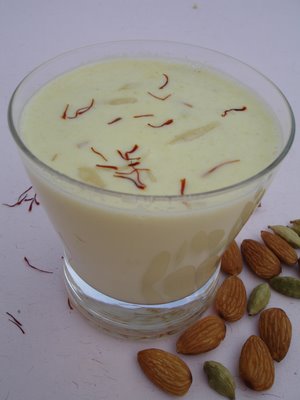 Badam Kheer Recipe
Badam Kheer Recipe
Ingredients:
25 almonds (badam pappu)
1 litre milk
1/4 cup water
1/2 cup sugar
4-5 crushed green cardamoms
10-15 strands saffron soaked in warm milk
Soak almonds in hot water for 15 minutes and peel the skin and grind the almonds to a paste adding half a cup of water.
Bring the milk to a boil in a heavy bottomed vessel and add the sugar and almond paste and then on low heat keep stirring once in while till the milk is reduced to 3/4 th of its quantity.Ensure that you stir so that it doesnt burn.
Add the cardamom pwd and stir well.Turn off heat.
Soak saffron strands in some warm milk and stir it well and add it to the kheer.
Garnish with silvered almonds and serve chilled.
Note:Badam Kheer,which is one of my family's favorite drink , can be made to a thicker consistency by boiling the milk till it is reduced to half its original quantity like payasam.I prefer to make it to a drinking consistency by boiling the milk to 3/4th of its original quantity.You can use low fat milk or half and half.The sugar quantity can be adjusted to your choice.It can also be served warm.
Almonds are highly nutritious and are essential nuts for growing children and also give a glow to our skin.Badam Kheer,a family favorite dessert drink ,joins my list of Indian Drinks And Sharbats and I would also like to share this Indian dessert recipe with Indira's series on Indian Sweets 101 Food,Food Blogs,Indian Drinks And Sharbats,Indian Sweets 101,Flickr
Today is Sri Rama Navami,an important festival especially among the Vaishnava sect of the Hindus. Sri Rama Navami falls on the ninth day of the Hindu lunar year (Chaitra Masam) and is observed as the wedding day of Lord Rama and Sita as well as the birthday of Lord Rama.This day also marks the end of the nine day Utsavam called Vasanthothsavam (festival of spring), that starts with Ugadi.Read more about Sri Rama Navami festival.
Today we prepare Panakam (Telugu) or Panaka (hindi), a festive sweet drink and a summer cooler prepared with jaggery and flavored with dry ginger,cardamom and pepper.We also prepare Vada Pappu (split yellow moong dal) with Chalimidi (rice flour based sweet) as naivedyam or prasadam.
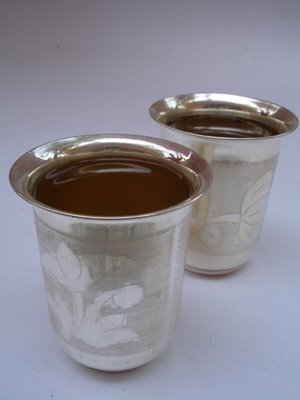 Panakam Recipe
Panakam Recipe
Ingredients:
2 tbsps grated jaggery
2 glasses water
pinch of dry ginger pwd
1 coarsely crushed cardamom
6-7 coarsely crushed pepper corns
Mix the grated jaggery in water and let it dissolve completely. Filter the jaggery water. Add dried ginger powder, crushed cardamom and crushed pepper. Mix well and serve it at room temperature or chilled.
Sometimes during the hot season I serve this traditional Indian drink as a summer cooler or a welcome drink to quench the thirst and its cooling properties helps to cool our system too. This age-old simple recipe has the luxury of the cardamom flavor,the sharp heat of the pepper and ginger pwd blending with the sweet flavor of jaggery water which is so refreshing that you can have 2-3 glasses at one go and still be asking for more..:).
Note:Ginger ,Pepper and Sonti (dry ginger) are traditionally recommended by Ayurvedic Nutrition to heal ailments of the stomach and throat and especially recommended as home remedies for cold and cough.
Vada Pappu And Chalimidi
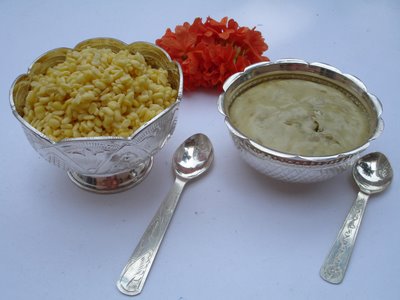 Vada pappu is split yellow moong dal (pesara pappu) soaked in water for half an hour and strained.This dal is not cooked and eaten along with chalimidi.
Vada pappu is split yellow moong dal (pesara pappu) soaked in water for half an hour and strained.This dal is not cooked and eaten along with chalimidi.
Chalimidi is prepared by soaking raw rice in water for 4-5 hours and the rice is spread out on a dry cloth and left to dry completely and then ground to a fine powder.To this rice powder(1 cup) add grated jaggery (1/2 cup) and coarsely crushed elachi. Wet your hands and mix the ingredients well for a few minutes till you get a smooth soft dough like appearence.Chalimidi is to be eaten in combination with vada pappu.
Panakam is my favorite traditional summer drink after majjiga which is made not only as a festive sweet drink but also as a summer cooler and adds to my list of Indian Drinks And Sharbats.For those who havent tried panakam as yet,do try it and you will love it for sure..:)
Food,Food Blogs,Andhra Recipes,Indian Drinks And Sharbats,Flickr
Andhras love their mirapakaayalu (green chillis)!Not only do we use them liberally to spice up our curries,pachi mirapakaayalu are used to prepare mirchi bajjis(stuffed green chillis),mirchi khatta masala curry ,mirchi ka salan(hyderabadi chilli delicacy)and a hot favorite (among the south indians) is majjiga mirapakaaylu (sun-dried chillis). Majjiga (buttermilk) mirapakaaya, a traditional Andhra recipe and as the name suggests, is green chillis soaked in sour buttermilk and sun-dried.Once the chillis are completely dried ,their color changes to a nice beige color and they develop a withered look.We usually make them in bulk during the summer season and sun dry them over our terraces where the heat of the sun is the maximum and preserved in air tight containers.They are also called voorumirapakaayalu (telugu) and mor molagai (tamil) and when deep-fried,attain a lovely brown shade,a nice crispy texture and a subtle combination of a sour-salty-spicy flavors and are eaten as an accompaniment to pappu annam (dal and rice),rice and curry and especially with curd rice.
Majjiga (buttermilk) mirapakaaya, a traditional Andhra recipe and as the name suggests, is green chillis soaked in sour buttermilk and sun-dried.Once the chillis are completely dried ,their color changes to a nice beige color and they develop a withered look.We usually make them in bulk during the summer season and sun dry them over our terraces where the heat of the sun is the maximum and preserved in air tight containers.They are also called voorumirapakaayalu (telugu) and mor molagai (tamil) and when deep-fried,attain a lovely brown shade,a nice crispy texture and a subtle combination of a sour-salty-spicy flavors and are eaten as an accompaniment to pappu annam (dal and rice),rice and curry and especially with curd rice.
Majjiga Mirapakaaya is a simple recipe but is a lenghty process and requires some patience as the preparation process is spread over a week.All you need are fresh green chillis,thick buttermilk(majjiga),salt and a bright hot sun..:)Usually I use the green chillis which have less spice (the ones shown in the picture below).Wash and pat dry the green chillis and make vertical slits half way along the green chilli on two sides.The slits have to be made such that the green chilli is intact and doesnt open up.Generally the seeds of this particular variety arent too many so I dont really remove the seeds, as when you make the slits a few seeds do pop out on their own.You can remove a few seeds but ensure you dont break the green chilli.Now soak them in enough quantity of thick buttermilk (one kilo of green chillis will require 2 tbsps of salt) with salt added to it till they are well immersed for 3 days (and nights).Cover and shake them twice a day. Take out the green chillis from the butter milk on the fourth day morning and sun dry it all day by spreading them over 4-5 sheets of newspapers or thick plastic sheet and put them back in the same majjiga again later in the evening at sunset(I usually do this between 6-7 pm). Remember to remove them in the evening and put them back in the buttermilk and let them sit in it all night before you again remove them the next morning to be sun-dried.Continue this process for atleast 3 days.Then throw away the left over sour buttermilk and continue to sun dry the chillis till completely dry (which is usually 3-4 days).
Take out the green chillis from the butter milk on the fourth day morning and sun dry it all day by spreading them over 4-5 sheets of newspapers or thick plastic sheet and put them back in the same majjiga again later in the evening at sunset(I usually do this between 6-7 pm). Remember to remove them in the evening and put them back in the buttermilk and let them sit in it all night before you again remove them the next morning to be sun-dried.Continue this process for atleast 3 days.Then throw away the left over sour buttermilk and continue to sun dry the chillis till completely dry (which is usually 3-4 days).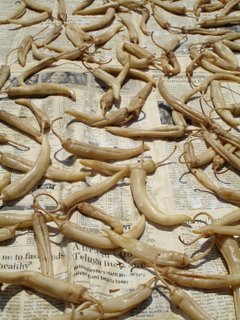 Store them in an air tight container and deep fry them in hot oil till crisp and golden brown (like you fry papad and vadiyaalu) as and when required.These dried chillis arent as spicy as they may appear and it also depends on the spice of the green chilli used in preparing the majjiga mirapakaayalu.If you are one of those who really likes a very spicy chilli then choose the spicer varieties of green chilli when preparing the majjiga mirapakaayalu.(The soaking of the chillis in majjiga will reduce the pungency of the green chilli whatever its spice level).There is another version of preparing the majjiga mirapakaayalu with stuffing (of carom seeds and cumin ) which I hope to share in my future posts.
Store them in an air tight container and deep fry them in hot oil till crisp and golden brown (like you fry papad and vadiyaalu) as and when required.These dried chillis arent as spicy as they may appear and it also depends on the spice of the green chilli used in preparing the majjiga mirapakaayalu.If you are one of those who really likes a very spicy chilli then choose the spicer varieties of green chilli when preparing the majjiga mirapakaayalu.(The soaking of the chillis in majjiga will reduce the pungency of the green chilli whatever its spice level).There is another version of preparing the majjiga mirapakaayalu with stuffing (of carom seeds and cumin ) which I hope to share in my future posts. The classic combination of flavors of this traditional Andhra favorite, majjiga mirapakaaya, will delight you and I find it hard to put in words the feeling you experience when you bite into a cruncy sun-dried chilli and savor its taste. Its simply heavenly! Even a simple curd rice when eaten with a majjiga mirapakaaya makes it a special meal.
The classic combination of flavors of this traditional Andhra favorite, majjiga mirapakaaya, will delight you and I find it hard to put in words the feeling you experience when you bite into a cruncy sun-dried chilli and savor its taste. Its simply heavenly! Even a simple curd rice when eaten with a majjiga mirapakaaya makes it a special meal.
Recipe Source: Amma Food,Food Blogs,Andhra Recipes,Indian Cooking,Flickr
Indian cuisine boasts of a wide array of savories ranging from simple plaintain chips to the irresistible samosa.Every region of India be it North or South,East or West ,has its own range of traditional savories which can be nibbled on any time of the day and make great accompaniments with coffee,tea or beverages/juices/cocktails.
Preparing traditional savories at home has drastically reduced over the past few years with most of them being available at home foods outlets in almost every city.I reminse my childhood days of the wonderful aromas emanating from ammamma’s and amma’s kitchens cooking savories like pakodas (fritters),jantikalu,muruku or chakli etc almost every other day and stored in big dabbas and how we would go scrambling into the pantry ,immediately on coming back from school, with pangs of hunger ,to devour them.
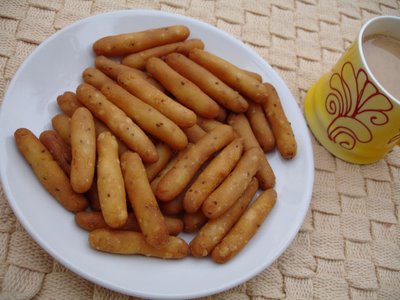 Home made traditional savouries do have their advantages over store bought ones in terms of freshness, price (costs much less),can be prepared suited to our palate and stored for atleast 2-3 weeks.We can never be sure of the store bought ones which most of the time lack the flavor and freshness of home made savories.Inspite of it we find that most homes are going in for store bought savories probably out of sheer convenience.I guess,it’s a personal choice.I ,for one, would prefer to prepare our traditional savories like jantikalu and murukku at home and very rarely pick up store bought ones.
Home made traditional savouries do have their advantages over store bought ones in terms of freshness, price (costs much less),can be prepared suited to our palate and stored for atleast 2-3 weeks.We can never be sure of the store bought ones which most of the time lack the flavor and freshness of home made savories.Inspite of it we find that most homes are going in for store bought savories probably out of sheer convenience.I guess,it’s a personal choice.I ,for one, would prefer to prepare our traditional savories like jantikalu and murukku at home and very rarely pick up store bought ones.
Palakayalu are a rice based dry and crispy savory,popular in Andhra.They are a hit with children and sometimes given to teething toddlers who nibble at them to remove the irritation they usually face during teething.They can be made both sweet and spicy.Today’s recipe is a salted version which is crisp with a slightly sweet flavor.If you want a spicy taste,add a tsp of ground green chilli paste to the dough.
Palakayalu Recipe (Rice Based Savory)
Ingredients:
2 cups of plain rice flour
1 ½ tsp sugar
salt to taste
1 tbsp oil
2 cups water
1 tbsp vaamu (ajwain,omamu,caram seeds)
oil for deep frying
Add salt, sugar and 1 tbsp of oil to water and bring to a boil.Add the rice flour to it stirring continuously till it forms a thick mixture and turn off heat.Cover and keep aside to cool.
Once cool add the vaamu and mix the dough well kneading for 2-3 minutes to form a smooth dough.Make small balls and roll them into (approx 2” )longitudinal shape.
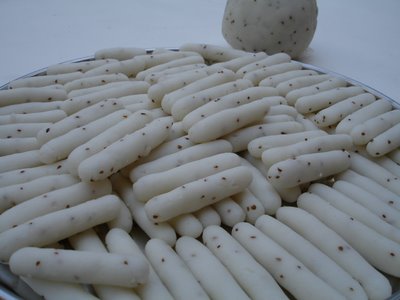 Heat oil in a deep frying pan and test the temperature of the oil by dropping a small ball of dough into the oil and if it sinks to the bottom ,it means the oil isn’t hot enough. If the ball springs to the top with bubbles all over,it means that the oil is ready to deep fry the palakayalu.Drop the palakayalu (about 30) gently into the hot oil and keep flipping them over till they are golden brown and crisp.
Heat oil in a deep frying pan and test the temperature of the oil by dropping a small ball of dough into the oil and if it sinks to the bottom ,it means the oil isn’t hot enough. If the ball springs to the top with bubbles all over,it means that the oil is ready to deep fry the palakayalu.Drop the palakayalu (about 30) gently into the hot oil and keep flipping them over till they are golden brown and crisp.
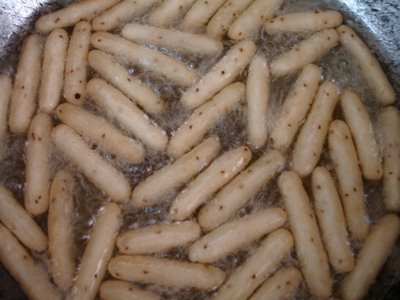 Drain onto absorbent paper and when cool,store the fried palakayalu in airtight containers.
Drain onto absorbent paper and when cool,store the fried palakayalu in airtight containers.
Note: Before you start deep frying them,ensure that you shape out the entire dough into longitudinal shapes and keep them covered.Deep fry them batch wise depending on the size of the deep frying pan.Dont add too many at once.
Enjoy a great tea time snack!
 Food,Food Blogs,Andhra Recipes,Indian Cooking,Snacks,Flickr
Food,Food Blogs,Andhra Recipes,Indian Cooking,Snacks,Flickr
With summer here,its barbeque time..:).I bought a new traditional earthern cooking stove a couple of days ago, called "Kumpati" in Telugu, where charcoal and firewood is used as a medium to cook food and is a popular stove with our rural folks. Kumpati, to us , serves as our "charcoal barbaque" and used often during summers to prepare chicken tikka,tandoori chicken and paneer tikkas.Its not like a typical tandoor but can be used as one and does serve the purpose of a tandoor to a certain extent.Kumpati basically uses "charcoal" as a cooking medium and the intense heat created by the hot coal cooks the food or meat very quickly giving it a crisp exterior and a soft and juicy interior and serves as a homestyle tandoor.

This cooking stove made of clay,has a hole in the front to feed the fire and holes on the top which act as burners.We can cook food directly over the coal embers or place a cooking vessel or pan over the hot coals to cook the food.Since its made of clay it holds in the heat and the food is cooked quickly.
This morning when we went for our walk along the beach road,we found some fishermen hauling their nets with a fresh catch of fish.We bought some fresh white pomfrets and I cleaned and marinated them in the morning keeping in mind that we could have a barbaque dinner later in the evening.Satish (my husband) is a very willing and enthusiastic helper especially with barbaques.He helped light up the coals and got the "kumpati" all ready to cook the fish in a jiffy..:)
 Charcoal Grilled Pomfret Recipe
Charcoal Grilled Pomfret Recipe
Ingredients:
4 big white pomfrets (chanduva or mackarel)
juice of one lemon
1 tbsp ginger garlic paste
big pinch turmeric pwd
1 tsp red chilli pwd
1 tsp coriander pwd
1/2 tsp cumin pwd
salt to taste
Wash, clean and dry the fish. Make slits on the fish and marinate it in salt and lime juice for 10 minutes.Meanwhile mix together ginger-garlic paste,turmeric pwd,chilli pwd,coriander pwd and cumin pwd and apply this paste to each of the fish and keep aside for atleast 2-3 hours.You can adjust the spiceness of the marinade according to your choice.I marinated the fish for around 10 hours and refrigerated it.Remember fish or meat marinated over a longer period tastes best as it absorbs the flavors well.
 Half an hour before you actually want to eat your dinner,get your kumpati (stove) up and ready by lighting up the charcoal and you should have red hot burning embers of coal like shown in the picture.
Half an hour before you actually want to eat your dinner,get your kumpati (stove) up and ready by lighting up the charcoal and you should have red hot burning embers of coal like shown in the picture.

Grease a grill or hot plate with big holes (like the one shown in the picture) and place the marinated fish (brush oil over the fish before placing it on the hot plate) over it and place the hot plate over the kumpati or hot stove.
Let it cook for 3-4 minutes and then turn the fish on the other side and let it cook for another 3-4 minutes or till golden brown. The real secret to grilling these pomfrets is to not overcook them.Watch closely as you cook the fish ...grill hot and fast and take it off the heat as soon as you can.
 You have a perfected cooked moist fish with a mellow smoky flavor ready to be devoured.Serve hot with slices of lemon wedges, salad and chutney.
You have a perfected cooked moist fish with a mellow smoky flavor ready to be devoured.Serve hot with slices of lemon wedges, salad and chutney.
Note:This fish tastes best when cooked in a tandoor or on a charcoal barbecue or kumpati.However if these methods of cooking are'nt available then use a grill or bake in the oven.
The spices used in the marination for cooking the pomfret differs region wise and the marinade for this particular fish is one which is popular in our home.I use different marinades using yogurt, garam masala and other spices each time I cook fish and hope to share them in my future posts.
Grilling/roasting over charcoal heat or tandoori cooking calls for very little fat or oil and the smoky flavor enhances the taste of the food cooked.So if you are want to cook some low calorie foods,investing in a grill or home tandoor does make sense.So all you weight watchers out there,here’s a very simple,low calorie,healthy,flavorful seafood Indian appetizer (cooked with minimal fat) that you will find hard to resist..:).
Some of the other seafood recipes I blogged earlier are Andhra Chepa Pulusu (Fish cooked in tangy gravy), Chepa Vepudu (Fish Fry), Spiced Fish Fillets and Royyalu Iguru (Prawns Curry) and
Royyalu Mungakaaya Kura (Prawn curry cooked with Drumsticks).
Food,Food Blogs,Fish,Indian Cooking,Low Calorie Recipes,Flickr
Today we are celebrating Ugadi,the Telugu New Year Day, which is the first festival of our Telugu calendar and the first big festival that comes after Sankranti.Our Andhra festival is known by different names in different states of India like “Gudi Padwa” in Maharastra and “Ugadi” in Andhra Pradesh and Karnataka.Whatever the name this festival takes in different regions,it heralds the dawn of Vasanth Rutu (Spring Season),which is considered the first season of the year (Chaitra Maasam) .Ugadi to the Telugu speaking people marks a beginning of a new year in which nature is in full bloom, symbolizing regeneration and celebrating the season’s freshness.
 With the coming of Ugadi, mango season is in full swing with fresh green mangoes flooding the rythu bazaars,garlands of marigold,roses,kanakaambaram, chamanti,naturally perfumed jasmine flowers (mallepuulu) which are in full bloom adorn the deities in temples and yes,you find most of our Andhra women’s braids are adorned with clusters of mallepuulu (jasmine flowers).The doorways of our homes are adorned with mango leaves which signifies prosperity and general well-being.But the most unique and significant tradition of Ugadi is beginning the new year with savoring a unique flavored pachadi (chutney) that epitomizes the spirit of Ugadi called "Ugadi Pachadi",with sweet,sour,pungent and bitter tastes (shadhruchulu or six tastes). This chutney or sauce is a symbolic reminder of the myriad facets of life in a sense prepares us for the year ahead.Of course,other than the special pachadi we also prepare special foods with the use of raw mango like papppu maamidikaaya,maamidi pulihora,maamidi kobari pachadi,pulihora,bobattulu, payasam and garellu.
With the coming of Ugadi, mango season is in full swing with fresh green mangoes flooding the rythu bazaars,garlands of marigold,roses,kanakaambaram, chamanti,naturally perfumed jasmine flowers (mallepuulu) which are in full bloom adorn the deities in temples and yes,you find most of our Andhra women’s braids are adorned with clusters of mallepuulu (jasmine flowers).The doorways of our homes are adorned with mango leaves which signifies prosperity and general well-being.But the most unique and significant tradition of Ugadi is beginning the new year with savoring a unique flavored pachadi (chutney) that epitomizes the spirit of Ugadi called "Ugadi Pachadi",with sweet,sour,pungent and bitter tastes (shadhruchulu or six tastes). This chutney or sauce is a symbolic reminder of the myriad facets of life in a sense prepares us for the year ahead.Of course,other than the special pachadi we also prepare special foods with the use of raw mango like papppu maamidikaaya,maamidi pulihora,maamidi kobari pachadi,pulihora,bobattulu, payasam and garellu.
Ugadi Pachadi is a special preparation prepared in every Andhra home on Telugu New Year’s day.Its made with fresh tamarind,jaggery(panela),fresh mangoes and neem flowers (margosa).One can add sugarcane,coconut and bananas also.The sweetness of jaggery,the sourness of tamarind,the bitterness of neemflower and the pungent flavor of the green mango skin,spice of the chilli powder ,raw tender mango’s taste and lastly salt form the shadhruchulu or six tastes of the sauce.
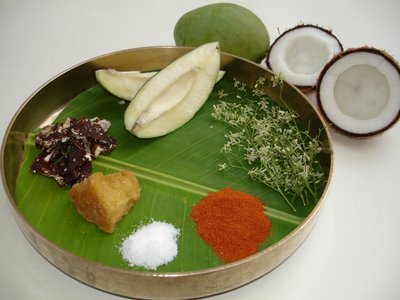
Andhra Ugadi Pachadi Recipe
Ingredients:
1 cup of raw fresh mango (cleaned and dried and finely chopped along with skin into small pieces)
1 tbsp of margosa flowers (neem tree flowers)
1 cup of grated jaggery
1 tbsp of fresh finely chopped coconut pieces (optional)
3 -4 tbsp tamarind paste
red chilli pwd (according to your choice)
salt to taste
Mix all the above ingredients to form a sauce like appearence.If you want a thin and watery chutney add very little water (2-3 tbsps).
Note: You can also add small pieces of sugarcane,pieces of ripe banana,putanaala pappu(roasted channa dal) along with the above ingredients.
Each home has its own version of preparing the ugadi pachadi but the main ingredients (reflecting all the six flavors) are as specified above.
The myriad rich taste of this delicacy tickles and lingers on our tongue for a long time leaving a medley of flavors.The flavors of the Ugadi Pachadi signifies that the mixture of bitter margosa flowers and sweet jaggery reflect the myriad facets of life,both joy and sorrow and prepares one to face both good and bad in the year to come.During this season we find people eating neem leaves and flowers at the onset of Vasantha Ruthu and through out the spring season as its a counter measure for kapha dosha individuals (kapha dosha increases around this period).Ugadi Pachadi is a healthy low calorie pachadi where the Neem flowers , new tamarind, jaggery and fresh raw mangoes contain nutrients that cleanse the system and act as prophylactics(prevention of illness or disease).

Ugadi Subhakankshulu!Wishing you all a very happy Ugadi and a great year ahead!
Food,
Food Blogs,
Vegetarian,
Telugu,
Andhra Recipes,
Flickr
Over the weekend,I cooked a very simple, visually appealing,wholesome, comforting ,nutritious meal with loads of vegetables and which didnt take in too much of cooking time.I really wasn’t in an adventurous mood and decided to play safe with the ingredients used in making a Indo-Chinese fusion meal, comprising of a vegetable stir fry and fried rice dish ,since we had an elderly guest visiting us for lunch.He is the typical Andhrite who loves his rice and chepa pulusu (fish cooked in a tangy spicy sauce) and whose meal has to have spice,definitely not bland.It was a challenge to me with hubby dear wanting to eat a meal with a Chinese flavor and a relative (with an uninitiated palate to Chinese cuisine)who loves spice and was willing to eat whatever I served him.What I like about Indo-Chinese fusion cooking is, you have enough room to experiment from scratch,don’t have to follow any particular cookbook method,less cooking time though the preparation time is much more than the actual cooking time..:)and the recipes are not traditional in the sense that they haven’t been passed down by our grandmothers.Indo-Chinese fusion cooking is versatile(free-style) in the fact that you can mix and match different foods and ingredients,flavors and textures to suit your palate and gives you the freedom to concote your own recipes. So here it is, my creation Indo-Chinese medley of a simple and easy ,yet flavorful and nutritious peanut flavored vegetable fried rice and vegetable stir fry in peanut-chilli sauce where the cooking style or technique is primarily Chinese and infused with Indian ingredients.Peanut Flavored Vegetable Fried RiceIngredients:2 cups of cooked basmati rice or any long grained rice(each grain should be separate and the rice should be completely cool)1 1/2 tbsp peanut oil1 bunch of chopped spring onions 2 green chilli slit length wise1 small cup of chopped carrots 1 small cup of chopped french beans1 small cup of chopped cabbage 1 small cup of boiled green peas½ tsp white pepper powder1 tbsp white vinegar2 tbsps of coarsely pwd roasted peanuts salt to taste Heat peanut oil to a smoking hot pan or wok and add the carrots and beans and stir fry them for 2 minutes and then add the cabbage, capsicum,green chillis and onions and stir fry on high heat tossing them about till the vegetable get tender.Now add the green peas.Immediately add the cold cooked rice ,salt,white pepper powder and peanut pwd and stir fry for sometime till rice and vegetables are nicely mixed together.Add the vinegar and stir in everything till well mixed and then sprinkle the chopped spring onions and stir it in and serve hot.Remove the green chillis from the rice before serving.
So here it is, my creation Indo-Chinese medley of a simple and easy ,yet flavorful and nutritious peanut flavored vegetable fried rice and vegetable stir fry in peanut-chilli sauce where the cooking style or technique is primarily Chinese and infused with Indian ingredients.Peanut Flavored Vegetable Fried RiceIngredients:2 cups of cooked basmati rice or any long grained rice(each grain should be separate and the rice should be completely cool)1 1/2 tbsp peanut oil1 bunch of chopped spring onions 2 green chilli slit length wise1 small cup of chopped carrots 1 small cup of chopped french beans1 small cup of chopped cabbage 1 small cup of boiled green peas½ tsp white pepper powder1 tbsp white vinegar2 tbsps of coarsely pwd roasted peanuts salt to taste Heat peanut oil to a smoking hot pan or wok and add the carrots and beans and stir fry them for 2 minutes and then add the cabbage, capsicum,green chillis and onions and stir fry on high heat tossing them about till the vegetable get tender.Now add the green peas.Immediately add the cold cooked rice ,salt,white pepper powder and peanut pwd and stir fry for sometime till rice and vegetables are nicely mixed together.Add the vinegar and stir in everything till well mixed and then sprinkle the chopped spring onions and stir it in and serve hot.Remove the green chillis from the rice before serving. Stir-Fried Vegetables in Peanut-Chilli Sauce
Stir-Fried Vegetables in Peanut-Chilli Sauce
Ingredients:1 green capsicum, cut into big pieces1 red capsicum, cut into big pieces2 onions (quartered)2 carrot thinly sliced (diagonally)1 bunch of spring onions,finely chopped1 small cup of boiled green peas1 cup cabbage cut into big pieces1 tsp freshly minced ginger2 tbsp peanut oil (I prefer peanut oil for the flavor it imparts to the food and it holds up to the hot-pan temp which is vital to chinese cooking) 1 tbsp soya sauce1 tbsp cornstarch mixed in 3-4 tbsps of waterFor sauce:7-8 tbsps of water7-8 garlic flakes (fry in a tsp of oil till rawness disappears)4-5 dry red chillis (deseed and soak in water for 10 minutes so that the pungency is reduced)..you can reduce the chillis if you want less spice3 tbsps roasted peanuts1 tbsp of grated jaggery (or brown sugar or panela)Grind all the above ingredients for the sauce to a paste. Heat a pan or wok to smoking hot and then add oil.Add minced ginger and stir fry for a few seconds and let the aroma permeate the kitchen.Now add carrots and stir fry for a minute and then add the cabbage,capsicum and onions.Now stir fry all the vegetables constantly till tender.Dont over cook them.They should be crunchy and crisp and not mushy.Now add the peanut chilli sauce and soya sauce and stir fry till the vegetables are well coated.Add 2-3 tbsps of water and salt, if your find the the sauce is getting stuck to the vessel.Dont fret.Its natural and keep stir frying for a few minutes and then add the cornstarch with the water and let it combine with the vegetables till your get a glazed look to the vegetables.Garnish with scallions and serve hot with any fried rice or noodles.Indeed,the vegetable fried rice generously flavored with peanuts and stir fry vegetable dish in a very flavorful sauce was delicious and had my guest asking for more.I knew my tyrst with Indo-Chinese fusion cooking was successful in initiating his palate to a totally new taste.I had earlier blogged about some of my adventures with Indian-Chinese fusion cooking like Sprouts Fried Rice,Spiced Fish Fillets and Sweet and Sour Chicken Legs,and they were devoured even before they reached the dining table..:).Since this fusion meal is loaded with nutritious vegetables,it makes an apt entry to Sweetnicks Anti-Oxidant Rich Foods ARF 5 Day as well as Meena's "From My Rasoi" March theme Fusion Foods.
Heat a pan or wok to smoking hot and then add oil.Add minced ginger and stir fry for a few seconds and let the aroma permeate the kitchen.Now add carrots and stir fry for a minute and then add the cabbage,capsicum and onions.Now stir fry all the vegetables constantly till tender.Dont over cook them.They should be crunchy and crisp and not mushy.Now add the peanut chilli sauce and soya sauce and stir fry till the vegetables are well coated.Add 2-3 tbsps of water and salt, if your find the the sauce is getting stuck to the vessel.Dont fret.Its natural and keep stir frying for a few minutes and then add the cornstarch with the water and let it combine with the vegetables till your get a glazed look to the vegetables.Garnish with scallions and serve hot with any fried rice or noodles.Indeed,the vegetable fried rice generously flavored with peanuts and stir fry vegetable dish in a very flavorful sauce was delicious and had my guest asking for more.I knew my tyrst with Indo-Chinese fusion cooking was successful in initiating his palate to a totally new taste.I had earlier blogged about some of my adventures with Indian-Chinese fusion cooking like Sprouts Fried Rice,Spiced Fish Fillets and Sweet and Sour Chicken Legs,and they were devoured even before they reached the dining table..:).Since this fusion meal is loaded with nutritious vegetables,it makes an apt entry to Sweetnicks Anti-Oxidant Rich Foods ARF 5 Day as well as Meena's "From My Rasoi" March theme Fusion Foods. Food,Food Blogs,Indo-Chinese Recipes,Cooking, Flickr
Summer time conjures up memories of big cool earthern pots of churned buttermilk kept in the open verandah of my tatayya’s (grandfather) farmhouse and those visiting him being offered a glass of cool refreshing ‘majjiga’ (Telugu term for buttermilk)-the quintessential summer drink.I reminse the good olden days of sharing some great moments with tatayya over a glass of chikkati majjiga (thick buttermilk). I grew up drinking ‘majjiga’ and it still is a routine affair in our home... call it a mix of tradition, habit , nutrition and comfort. Visit any Andhra home during summer time and you are sure to be welcomed with a chilled glass of majjiga (moru(Tamil),majjige(Kannada),chaas(Gujarati),lassi(punjabi)).
 Majjiga is an integral part of Andhra cuisine and no meal is complete without Majjiga which is usually taken towards the end of a meal as it has the ability to enhance digestion.Majjiga which is known by different names in the West like Salted Yogurt Drink,Yogurt Shake and Indian Drinking Yogurt is a blend of three tastes which are sweet,sour and astringent.Majjiga is one of the easiest recipes even a 6 year old can whip up and is nothing but a blend of fresh curds,plain water and salt.Replace the salt with sugar and it becomes Sweet Lassi,a very popular sweet drink beverage in North India,having its origins in Punjab.
Majjiga is an integral part of Andhra cuisine and no meal is complete without Majjiga which is usually taken towards the end of a meal as it has the ability to enhance digestion.Majjiga which is known by different names in the West like Salted Yogurt Drink,Yogurt Shake and Indian Drinking Yogurt is a blend of three tastes which are sweet,sour and astringent.Majjiga is one of the easiest recipes even a 6 year old can whip up and is nothing but a blend of fresh curds,plain water and salt.Replace the salt with sugar and it becomes Sweet Lassi,a very popular sweet drink beverage in North India,having its origins in Punjab.
The best way to prepare ‘majjiga’ is to always use fresh home made curds and mix it in equal parts of water to make a thick buttermilk (chikkati majjiga).For a more thinner majjiga add 3 parts of water to one part of curds and use a hand churner or kavvam (traditional wooden or stainless steel churner) to churn the mixture ,rolling it back and forth between your hands.
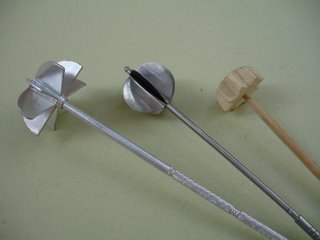 Do this for 2 minutes.This action helps in blending the mixture well and any fat which is in the curd will separate and rise to the top.Skim off the fat.(If you don’t have a hand churner similar to the ones shown in the picture ,use a blender to blend on low speed for a minute)
Do this for 2 minutes.This action helps in blending the mixture well and any fat which is in the curd will separate and rise to the top.Skim off the fat.(If you don’t have a hand churner similar to the ones shown in the picture ,use a blender to blend on low speed for a minute)
Andhra Spiced Buttermilk is a soothing combination of fresh home made curds,water,fresh curry leaves,crushed ginger,green chillis,salt and a dash of lemon juice.This spice and herb infused drink is a perfect blend of myriad flavors ….sweet,spicy,sour and salty which balances and pacifies all the three doshas.Vata,Pitta and Kapha,strengthens and increases our appetite and digestive power.
Andhra Spiced Buttermilk
Ingredients:
4 glasses of buttermilk(made from 4 parts water and 1 part curds)
1-2 green chillies finely chopped (adjust according to your choice)
½” ginger piece grated or crushed
few curry leaves (only fresh leaves)
1-2 tbsp lemon juice
salt to taste
coriander leaves(optional)
Mix all the above ingredients and chill.Serve cold.
Another variation is to add a tempering of mustard seeds and curry leaves to the above prepared majjiga.Heat ½ tsp of oil in a pan and add 1/2 tsp of mustard seeds and let them splutter.Add the curry leaves and let the flavors blend in the oil, remove from heat and immediately add to the majjiga and cover for a few minutes and then blend with a churner for a minute and chill. Serve cold.
 Another version is nimmakaaya majjiga or nimma majjiga which is plain salted majjiga (blend of curds and water)with a dash of lemon juice.
Another version is nimmakaaya majjiga or nimma majjiga which is plain salted majjiga (blend of curds and water)with a dash of lemon juice.
North Indian version of buttermilk or lassi calls for the use of rock salt,dry roasted cumin pwd and fresh mint leaves.Read more about Lassi.
Each home has its own version of buttermilk be it North, South ,East or West.The basic recipe of buttermilk is the same,only the infusion of spices and herbs differs according to each home or region.Read more about curds or yogurt and home made yogurt.
Ayurvedic nutrition recommends buttermilk to pacify Pitta dosha (with the addition of sugar or rose water), pacify Vata and Kapha (use of rock salt, honey,spices like dry-roasted cumin pwd, black pepper and herbs like ginger).Buttermilk is highly recommended as one the best home remedies for certain ailments like piles,diarrhoea,jaundice and dysfunctions of liver and spleen.Read more about the benefits of buttermilk.
This traditional thrist-quenching refreshing drink with high therapeutic and nutritional properties is appetizing,cooling,rejunuvating,soothing and serves as an excellent antidote to sunstrokes during Indian peak summer times. It tones the small intenstine,very light on the stomach and easy to digest unlike other dairy products like cheese and paneer.It goes without saying that majjiga is the healthiest low calorie milk product among the many dairy products and works as a good calcium substitute for the high calorie dairy products.
Buttermilk serves as a good home remedy for removing sun tan.Apply buttermilk to the face and rinse off with cool water, once dry.Do this regularly and your tan disappears and your face gets back it lost glow.So it works as a beauty enhancer too…:)
I had to start with my series on “Indian Drinks & Sharbats” with this heavenly traditional drink which most of us in Andhra cannot do without.So instead of heading for aerated drinks this summer,try out the irresistible, nourishing,old-fashioned beverage 'majjiga' which will revitalize you and keep you cool throughout the delirious hot season.
Food,Food Blogs,Vegetarian,Indian Drinks And Sharbats,Andhra Recipes,Flickr
 Well,summer is officially here in India.Its getting hot and as we reside in a coastal area of Andhra Pradesh,the humidity levels are pretty high.Inspite of the sweltering heat,this is the time of the year I look forward to barbecues, watermelons,sweet juicy ripe mangoes,corn on the cob,lemonades and healthy fresh fruit drinks. Summer offers a wider variety vegetables than any other season and ripe and juicy fruits like watermelons, guavas,lichees, mangoes, musk melons, sweet lime (mousambi), oranges,papaya, grapes,bananas, pineapples, sapota(chikku), pomegranate are available in abundance absolutely fresh from the farm and sold by the farmers themselves at the Rythu Bazaars (Farmer’s Market) at very reasonable prices(as there is no middle man involved here).
Well,summer is officially here in India.Its getting hot and as we reside in a coastal area of Andhra Pradesh,the humidity levels are pretty high.Inspite of the sweltering heat,this is the time of the year I look forward to barbecues, watermelons,sweet juicy ripe mangoes,corn on the cob,lemonades and healthy fresh fruit drinks. Summer offers a wider variety vegetables than any other season and ripe and juicy fruits like watermelons, guavas,lichees, mangoes, musk melons, sweet lime (mousambi), oranges,papaya, grapes,bananas, pineapples, sapota(chikku), pomegranate are available in abundance absolutely fresh from the farm and sold by the farmers themselves at the Rythu Bazaars (Farmer’s Market) at very reasonable prices(as there is no middle man involved here).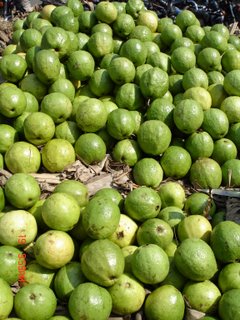 It’s an absolute delight to visit the Rythu Bazaar and interact with the farmers and watch them arrange the fresh produce early in the morning...:)Infact I visit the Rythu Bazaar ,which is a stone’s throw away from my home,almost everyday on my way back home after my morning walk to pick up fresh vegetables and fruits.You can look forward to seeing some pictures of Rythu Bazaar,the farmers and their produce in my future posts.During the entire summer season, I make a variety of cool thirst-quenching refreshing fruit drinks and salads almost every day.Summer is extremely harsh on us here in India and sometimes the temperature soars as high as 47 degrees Celsius and the coastal areas face high humidity.Its very common to find people suffering from heat strokes,heat exhaustion and heat stress during these hot weather months.The only mantra I follow for myself and my family to keep the body cool and prevent dehydration is by drinking plenty of fluids and eat an abundance of fruits and vegetables and reduce intake of oily and spicy food.Our consumption of vegetables and fruits during these summer months is the highest than in any other season.I want to share some of the tips I generally follow during the summer season to beat the sizzling heat and stay cool.Drink water,water and more water...I consume a lot of fluids and drink atleast 12 glasses of water ..ie about 4 litres of water.If you have difficulty in drinking 12 glasses of water,ensure that you can drink atleast 8 glasses of water and supplement your water intake with healthy drinks of your choice like a lemonade or fresh fruit drinks.You don’t have to concote a fancy sharbat or drink,even a humble lemonade or nimmakaaya neelu (nimbu paani) will do.When we are sweating, our bodies are losing out on essential moisture and minerals like potassium and eating fresh fruits or intake of fruit drinks and healthy salads replenishes minerals and helps absorb and retain fluids and helps us stay hydrated and refreshed.We drink a lot of tender coconut water throughout the summer season and we are fortunate to have home grown coconut trees.Those pictures you see are the coconut trees grown in our garden.Tender coconut water is the best bet for the hot summer.I just love the soft and creamy pulp of a tender coconut..its simply heavenly..:)According to Ayurvedic nutrition the liquid from a tender coconut (90% is water) is so pure and cooling with immense healing properties and is known to pacify pitta dosha and alleviates any pitta-related disorders.
It’s an absolute delight to visit the Rythu Bazaar and interact with the farmers and watch them arrange the fresh produce early in the morning...:)Infact I visit the Rythu Bazaar ,which is a stone’s throw away from my home,almost everyday on my way back home after my morning walk to pick up fresh vegetables and fruits.You can look forward to seeing some pictures of Rythu Bazaar,the farmers and their produce in my future posts.During the entire summer season, I make a variety of cool thirst-quenching refreshing fruit drinks and salads almost every day.Summer is extremely harsh on us here in India and sometimes the temperature soars as high as 47 degrees Celsius and the coastal areas face high humidity.Its very common to find people suffering from heat strokes,heat exhaustion and heat stress during these hot weather months.The only mantra I follow for myself and my family to keep the body cool and prevent dehydration is by drinking plenty of fluids and eat an abundance of fruits and vegetables and reduce intake of oily and spicy food.Our consumption of vegetables and fruits during these summer months is the highest than in any other season.I want to share some of the tips I generally follow during the summer season to beat the sizzling heat and stay cool.Drink water,water and more water...I consume a lot of fluids and drink atleast 12 glasses of water ..ie about 4 litres of water.If you have difficulty in drinking 12 glasses of water,ensure that you can drink atleast 8 glasses of water and supplement your water intake with healthy drinks of your choice like a lemonade or fresh fruit drinks.You don’t have to concote a fancy sharbat or drink,even a humble lemonade or nimmakaaya neelu (nimbu paani) will do.When we are sweating, our bodies are losing out on essential moisture and minerals like potassium and eating fresh fruits or intake of fruit drinks and healthy salads replenishes minerals and helps absorb and retain fluids and helps us stay hydrated and refreshed.We drink a lot of tender coconut water throughout the summer season and we are fortunate to have home grown coconut trees.Those pictures you see are the coconut trees grown in our garden.Tender coconut water is the best bet for the hot summer.I just love the soft and creamy pulp of a tender coconut..its simply heavenly..:)According to Ayurvedic nutrition the liquid from a tender coconut (90% is water) is so pure and cooling with immense healing properties and is known to pacify pitta dosha and alleviates any pitta-related disorders. I guess, most of us are used to air-conditioned environments during the summer season. My advice is to avoid extreme changes in temperature at once. If you are feeling extremely hot and are sweating, due to the sweltering heat,then don’t get into an air-conditioned environment immediately on entering your home.First try to cool your body down (room temperature) before getting into the luxury of your air-conditioned room. Our bodies should not be exposed to extreme temperature variations.Try to use as much of ceiling or floor fans to keep cool than AC’s.We spread dry coconut branches and palm leaves all over our terrace and use coir blinds to cover our windows to prevent heat of the hot sun from entering the house and wet the coir blinds which helps in lowering the temperature inside the house.
I guess, most of us are used to air-conditioned environments during the summer season. My advice is to avoid extreme changes in temperature at once. If you are feeling extremely hot and are sweating, due to the sweltering heat,then don’t get into an air-conditioned environment immediately on entering your home.First try to cool your body down (room temperature) before getting into the luxury of your air-conditioned room. Our bodies should not be exposed to extreme temperature variations.Try to use as much of ceiling or floor fans to keep cool than AC’s.We spread dry coconut branches and palm leaves all over our terrace and use coir blinds to cover our windows to prevent heat of the hot sun from entering the house and wet the coir blinds which helps in lowering the temperature inside the house. Avoid all aerated beverages and ice cold drinks with preservatives.They are a big 'no-no' and are banned in my home.I cant stress enough the importance of incorporating fruits in your daily diet regime which gives you fiber,vitamin C and strengthens the immune system.FRUITS to me are absolutely heavenly and are 'manna from heaven' and I can live off fruits..:).They are packed with nutrition, almost negligible calories,minimal fat,full of vitamins, phytonutrients and fibre and easily digestable.There’s nothing more delicious and nutritious as thirst-quenching refreshing drinks and fruit salads and with the abundance of fresh fruit choices available ,you sure can beat the heat and make this summer a savory experience.I hope to share with you a few of these fruit drinks and sharbats in my future posts.
Avoid all aerated beverages and ice cold drinks with preservatives.They are a big 'no-no' and are banned in my home.I cant stress enough the importance of incorporating fruits in your daily diet regime which gives you fiber,vitamin C and strengthens the immune system.FRUITS to me are absolutely heavenly and are 'manna from heaven' and I can live off fruits..:).They are packed with nutrition, almost negligible calories,minimal fat,full of vitamins, phytonutrients and fibre and easily digestable.There’s nothing more delicious and nutritious as thirst-quenching refreshing drinks and fruit salads and with the abundance of fresh fruit choices available ,you sure can beat the heat and make this summer a savory experience.I hope to share with you a few of these fruit drinks and sharbats in my future posts.
There are numerous ways to prepare refreshing fruit drinks and sharbats which are not only delicious but low in calories and full of nutrition.Most of them are traditional health drinks,herbal drinks and yes,they work on our skin as well and you can call them beauty enhancers too..:)These have worked for me and I hope they help you too.You will find that they are so simple to prepare with the least number of ingredients and yet effective in not only keeping us cool and healthy and bring out that shine to our skin and glow to the face.I look forward to sharing with you in my series on “Indian Drinks & Sharbats”,some healthy and refreshing fruit drinks,herbal drinks and sharbets which I prepare for my family during the summer season.So stay tuned..:)
Green Eggplant or green brinjal,one of the varieties in brinjals (eggplant,aubergine,vankaaya,baingan or badinjan), is one of the most common vegetable which is grown all year round in Andhra Pradesh,the state I belong.They are round to oval in shape with a thinner skin unlike the purple eggplants.The small purple variety of brinjals are used to prepare the famous Andhra delicacy Gutti Vankaaya Kura (stuffed brinjal curry).The green brinjal has fewer seeds and are white which is a sign that they are fresh and tender.These eggplants have a delicate flavor and cook easily and are best suited to prepare this dish and Vankaaya Pachadi, an Andhra brinjal chutney recipe similar to Baingan Ka Bharta.
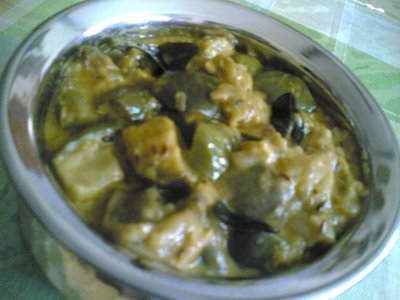 These eggplants sometimes have a bitter taste,especially during summers, and you can offset the bitterness by sprinkling a tsp of salt over them and place them in a colander so that the bitter juice of the brinjal pieces trickles down.Then wash them thoroughly in water and squeeze off excess water.Vakaaya Paalu (milk) Posina (pour) Kura is a very simple, easy-to-make,low fat dish where the brinjals (as name suggests in Telugu) are blended in milk which give the curry a rich and sweet flavor.
These eggplants sometimes have a bitter taste,especially during summers, and you can offset the bitterness by sprinkling a tsp of salt over them and place them in a colander so that the bitter juice of the brinjal pieces trickles down.Then wash them thoroughly in water and squeeze off excess water.Vakaaya Paalu (milk) Posina (pour) Kura is a very simple, easy-to-make,low fat dish where the brinjals (as name suggests in Telugu) are blended in milk which give the curry a rich and sweet flavor.
Vankaaya Paalu Posina Kura
Ingredients
1 large green brinjal (chopped into small cubes and place in salted water for 10 mts)
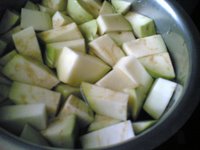
1 finely chopped onion
1 slit green chilli
1 tsp cumin seeds
5-6 slightly crushed garlic cloves
1” finely minced ginger piece
1 tsp red chilli pwd ( adjust according to your choice)
pinch of turmeric pwd
1 tsp coriander pwd
salt to taste
1 cup skimmed milk
10 curry leaves
1 tbsp oil
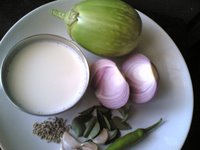
Heat oil in a cooking vessel ,add the cumin seeds and let them brown.
Now add the garlic,ginger,curry leaves and green chilli and fry for a few seconds taking care not to burn the tempering.
Add the chopped onions and saute till the onions turn pink.
Add the chopped brinjals and saute them for a few mts.Add the chilli pwd,coriander pwd and turmeric pwd.Combine.
Add salt and continue to saute for another 3-4 mts on slow fire covered till the brinjals are almost cooked.
Now add the milk and go on stirring on medium heat till milk is completely combined with the brinjals and you attain a thick curry consistency…this could take about 7-8 mts.You need to ensure that the milk doesn’t curdle,so keep stirring till the brinjals are fully cooked in the milk and then turn off fire.
Serve with hot steamed rice or rotis.

Note:You can make this curry with other brinjal varieties like Thai Eggplants or the purple variety.Ensure that they are tender and offset any bitterness before cooking the brinjals.
Some tips on cooking brinjals that I generally follow.If the skin is shrivelled and the seeds are black,don’t even think of using them, as they have matured and best discarded.Try to avoid cooking them in metallic utensils as they discolor the eggplants.Soak the chopped brinjals in water as they discolor when exposed to air.Soaking the eggplants in salted water before cooking ensures that the salted water draws out the moisture and removes any bitterness and hence absorbs less fat while cooking.Try to cook brinjals with the skin as the skin of the brinjal is rich in flavonoids and other antioxidants, which can help reduce the risk of heart disease.
Chlorogenic acid, an anti-oxidant found in eggplants, is especially potent, with research suggesting it has anti-cancer, anti-microbial and anti-viral properties, as well as an ability to help reduce levels of "bad" LDL cholesterol.Eggplant benefits those suffering from high blood pressure and due to its richness in vitamin D, it helps to strengthen our blood vessels and clear blood clots, thereby preventing stroke.Eggplant is low in calories,high in potassium and vitamin K with good fibre content.Read more about the medicinal and health benefits of eggplants.An ayurvedic remedy for indigestion is to drink soup made of brinjal and tomato and this vegetable helps overcome constipation too.Hopefully, the health benefits of eggplants should encourage all those brinjal haters to venture into their kitchens and whip up a simple low calorie delicious dish like Vankaaya Paalu Posina Kura..:)
Food,Food Blogs,Cuisine,Indian Cooking,Andhra Recipes,Flickr











































